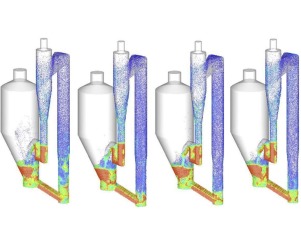Particuology ( IF 4.1 ) Pub Date : 2017-08-24 , DOI: 10.1016/j.partic.2017.04.009 Stephan Kraft , Friedrich Kirnbauer , Hermann Hofbauer

|
A cold flow model of an 8 MW dual fluidized bed (DFB) system is simulated using the commercial computational particle fluid dynamics (CPFD) software package Barracuda. The DFB system comprises a bubbling bed connected to a fast fluidized bed with the bed material circulating between them. As the hydrodynamics in hot DFB plants are complex because of high temperatures and many chemical reaction processes, cold flow models are used. Performing numerical simulations of cold flows enables a focus on the hydrodynamics as the chemistry and heat and mass transfer processes can be put aside. The drag law has a major influence on the hydrodynamics, and therefore its influence on pressure, particle distribution, and bed material recirculation rate is calculated using Barracuda and its results are compared with experimental results. The drag laws used were energy-minimization multiscale (EMMS), Ganser, Turton–Levenspiel, and a combination of Wen–Yu/Ergun. Eleven operating points were chosen for that study and each was calculated with the aforementioned drag laws. The EMMS drag law best predicted the pressure and distribution of the bed material in the different parts of the DFB system. For predicting the bed material recirculation rate, the Ganser drag law showed the best results. However, the drag laws often were not able to predict the experimentally found trends of the bed material recirculation rate. Indeed, the drag law significantly influences the hydrodynamic outcomes in a DFB system and must be chosen carefully to obtain meaningful simulation results. More research may enable recommendations as to which drag law is useful in simulations of a DFB system with CPFD.
中文翻译:

借助CPFD在8 MW双流化床系统冷流模型中阻力定律对压力和床料再循环率的影响
使用商业计算粒子流体动力学(CPFD)软件包Barracuda对8 MW双流化床(DFB)系统的冷流模型进行了仿真。DFB系统包括一个连接到快速流化床的鼓泡床,其中床层材料在它们之间循环。由于高温和许多化学反应过程,热的DFB工厂的流体动力学非常复杂,因此使用了冷流模型。对冷流进行数值模拟可以将注意力集中在流体动力学上,因为化学,传热和传质过程可以放在一边。阻力定律对流体动力学有重要影响,因此使用梭子鱼计算了其对压力,颗粒分布和床层再循环率的影响,并将其结果与实验结果进行了比较。使用的阻力定律是能量最小化多尺度(EMMS),Ganser,Turton-Levenspiel和Wen-Yu / Ergun的组合。为该研究选择了11个工作点,并根据上述阻力定律对每个工作点进行了计算。EMMS阻力定律最好地预测了DFB系统不同部分中床层材料的压力和分布。为了预测床层物料的再循环速度,Ganser阻力定律显示了最佳结果。但是,阻力定律通常无法预测实验发现的床层物料再循环率趋势。实际上,阻力定律会显着影响DFB系统中的流体动力学结果,因此必须谨慎选择以获取有意义的仿真结果。进行更多的研究可能会提出一些建议,以建议哪种阻力定律在使用CPFD的DFB系统仿真中有用。











































 京公网安备 11010802027423号
京公网安备 11010802027423号